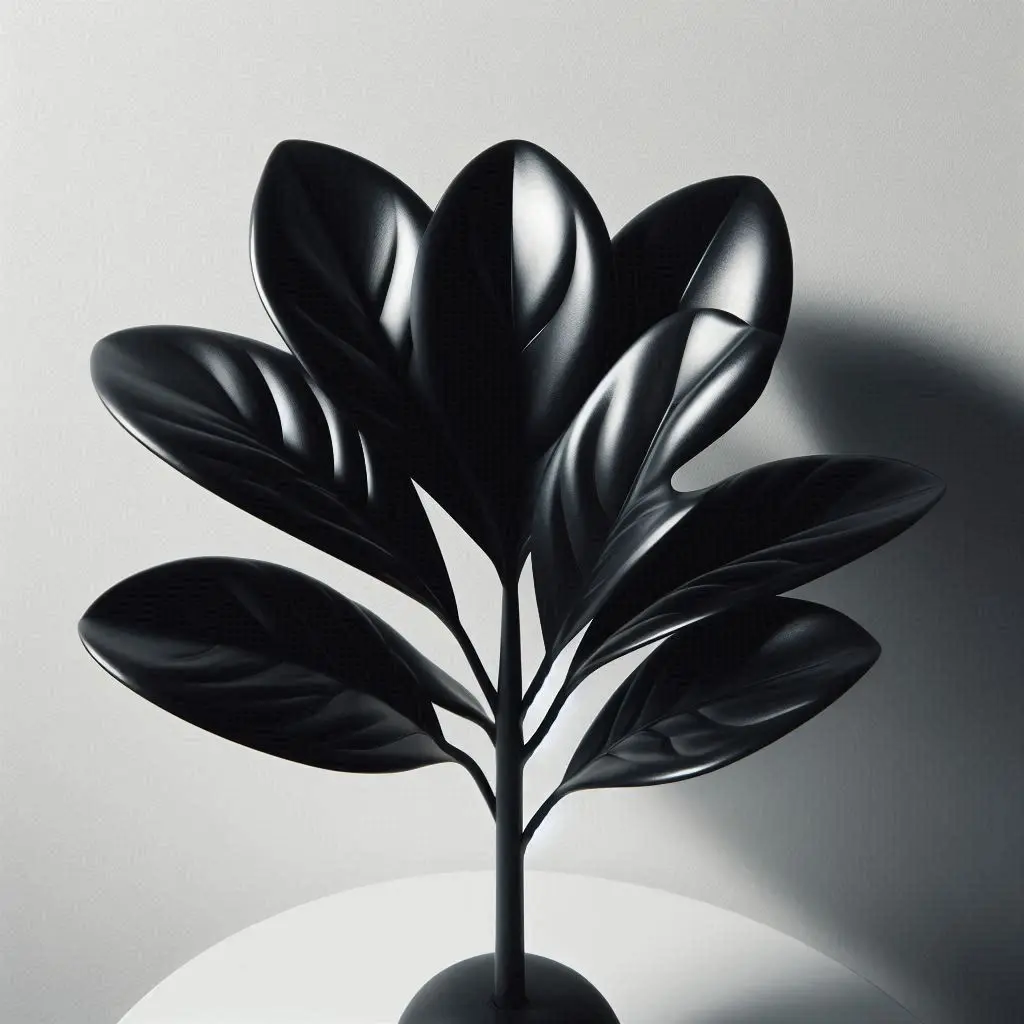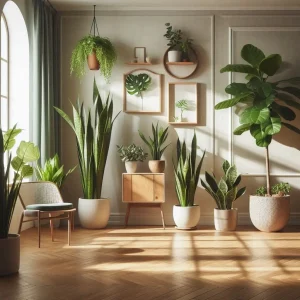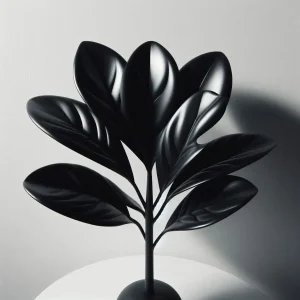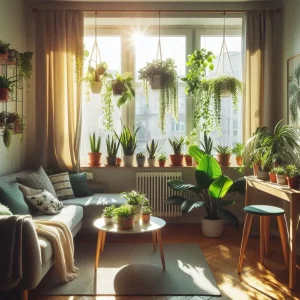Zamioculcas Black first emerged in a greenhouse in South Korea in 2006. In that year, the greenhouse owner noticed a black shoot growing on one of the Zamioculcas plants. This mutation had naturally occurred in the plant, and after successive propagations, this characteristic was passed down to the plant’s subsequent generations. This event has led to the presence and cultivation of Zamioculcas Black or Zamioculcas Black in greenhouses and homes to this day.
Caring for Zamioculcas Black or Zamioculcas Black is quite straightforward! In other words, Zamioculcas Black can control water and nutrient consumption and storage through its rhizome. The rhizome, or underground stem, is a horizontal structure from which the plant’s branches and roots grow. This part of the plant also handles the storage of necessary materials. The presence of the rhizome in Zamioculcas Black allows the plant to grow even for several weeks without the need for watering. Therefore, if you tend to forget to water your plants most of the time, taking care of Zamioculcas Black or Zamioculcas Black is an excellent choice for you.
**History of Emergence and Characteristics of Zamioculcas zamiifolia ‘Raven’:**
The origin of Zamioculcas zamiifolia ‘Raven’ dates back to 2006. In that year, an individual in a South Korean greenhouse discovered Zamioculcas zamiifolia with dark-colored branches. The dark coloration of the leaves in Zamioculcas ‘Raven’ is, in fact, a natural mutation. If you see a significant number of Zamioculcas ‘Raven’ in greenhouses these days, it is the result of propagating the original dark-colored branch first found in South Korea.
- Common Name: Zamioculcas Raven, Black ZZ Plant
- Scientific Name: Zamioculcas zamiifolia ‘Raven’
- Family: Araceae
- Plant Type: Perennial, Rhizomatous
- Mature Plant Size: Approximately 72 centimeters
- Light Requirement: Partial sunlight and some shade
- Soil Type: Sandy with good drainage
- Soil PH:Slightly acidic
- Flowering Time:Spring, Summer
- Flower Color:Green
- Native Region:Asia
- Toxicity:Toxic to humans and animals
| Attribute | Information |
| Common Name | Zamioculcas Raven, Black ZZ Plant |
| Scientific Name | Zamioculcas zamiifolia ‘Raven’ |
| Family | Araceae |
| Plant Type | Perennial, Rhizomatous |
| Mature Plant Size | Approximately 72 centimeters |
| Light Requirement | Partial sunlight and some shade |
| Soil Type | Sandy with good drainage |
| Soil pH | Slightly acidic |
| Flowering Time | Spring, Summer |
| Flower Color | Green |
| Native Region | Asia |
| Toxicity | Toxic to humans and animals |
Zamioculcas Black can tolerate various environmental conditions and is relatively resistant to various pests and diseases. It’s interesting to note that the shoots of Zamioculcas Black are surprisingly bright green and will gradually change to dark purple over time.
It’s worth knowing that during the growing season and under ideal environmental conditions, Zamioculcas Black can grow up to one centimeter per day! This rapid growth usually occurs after a long dormant period. So, if you’ve provided all the care conditions for your Zamioculcas Black, and the plant is pest-free, but you don’t see any growth, don’t worry – your plant is likely in a dormant phase.
Watering:
Page Contents
ToggleDuring the care of Zamioculcas Black, or Zamioculcas Black, water it when the soil is completely dry. As mentioned before, this plant has a rhizome that stores some water for the plant’s consumption. The stored water in the rhizome is released when needed, making the plant resistant to drought. While this ability reduces the need for frequent watering, it’s essential to avoid overwatering. You might think that giving more water will result in storing more, but that’s not the case. Overwatering can harm the plant without providing any additional benefit. Therefore, always prioritize the plant’s needs and its capacity to receive water. Water it as needed and appropriately when the soil is completely dry.
For accurate information on when to water Zamioculcas Black, simply insert your finger or a wooden stick into the soil and check its moisture content. If the soil is completely dry, it’s time to water the plant.
readmore: 15 birds safe houseplants
Light Requirements for Zamioculcas Black:
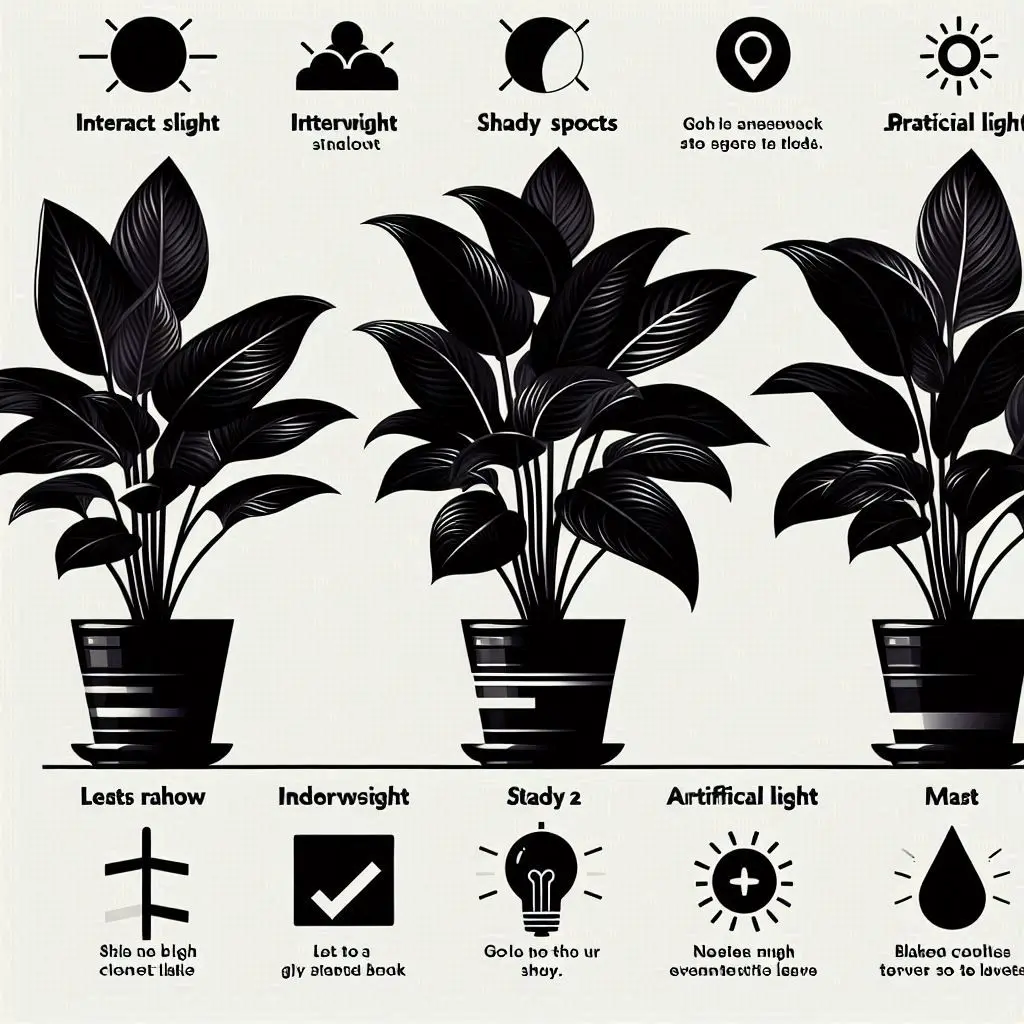
Zamioculcas, including Zamioculcas Black, are known for their shade-tolerance and ability to thrive in low-light conditions. While Zamioculcas Black can survive in low light, it prefers receiving adequate but indirect sunlight. A brighter environment will promote more significant growth, resulting in a larger Zamioculcas plant.
It’s worth noting that Zamioculcas Black is one of the few plants that can tolerate being placed in areas with minimal natural light, such as bathrooms or hallways without windows. However, it is strongly advised not to keep the plant in such locations, as it may ultimately lead to the demise of the plant.
Although Zamioculcas Black can survive in low-light conditions, its preference is for receiving sufficient but indirect sunlight. The brighter the environment, the more robust the plant’s growth. During the care of Zamioculcas Black, make sure that direct sunlight does not reach the plant, especially during peak hours from 11 am to 3 pm, as direct sunlight can lead to plant damage and leaf scorching.
Our suggestion is to place the Zamioculcas Black (ZZ Black) near a south-facing window to provide adequate light for its maintenance.
For the suitable soil for Zamioculcas Black or ZZ plant, it is recommended to use well-draining black soil. If you already have potting soil at home, adding a few handfuls of perlite or vermiculite to it will improve its quality for ZZ Black. If you intend to buy fresh soil, make sure it contains some perlite in its composition.
The next point to consider is the presence of drainage holes at the bottom of the pot. Without these holes, proper drainage will not occur. Therefore, soil preparation and having multiple drainage holes under the pot are equally important.
Fertilization:
To promote plant growth, apply balanced fertilizer to it every 2 to 3 months. Choose a liquid fertilizer with an NPK ratio (Nitrogen, Phosphorus, and Potassium) of 1:1:1 or 20:20:20 (both sets of numbers are equivalent). For fertilizing, dilute the recommended amount on the fertilizer packaging in water and add it to the soil. Be careful to always apply fertilizer to moist soil to prevent plant burn and avoid damaging the roots. Therefore, it’s better to fertilize along with watering the plant. Also, when the cold season arrives and the dormant period begins, you should stop fertilization.
In general, Zamiifolia Black is not very fond of fertilizer. So if for any reason you forget this step, there’s no need to blame yourself. The plant may experience a slight reduction in growth, but it is still alive and will continue its life.
Temperature and humidity requirements for Zamiifolia Black:
Place your Zamiifolia Black in an environment with a temperature above 10 degrees Celsius and keep it away from heating/cooling devices. For this purpose, the temperature range typical for homes is suitable for the growth of this plant, and there is no need for specific actions in this regard.
It’s worth mentioning that if you live in a region with mild winters, you can also place your Zamiifolia Black outdoors, but be careful not to expose the plant to temperatures below 5 degrees Celsius.
Once temperature is covered, let’s move on to the humidity requirements for Zamiifolia Black. Fortunately, Zamiifolia Black doesn’t require a specific level of humidity, and normal household humidity is sufficient for it. Just make sure not to place it near entrances and, as mentioned before, keep it away from heating/cooling devices.
The safety of Zamiifolia Black for children and household pets is a concern, as it is considered a toxic plant due to the presence of calcium oxalate crystals in all parts of the plant. Although these compounds are not lethal, contact with the plant’s sap may cause localized inflammation on the skin. Therefore, if you find yourself in a situation where you need to prune the plant or change its pot, it’s essential to use gloves.
During the care of Zamiifolia Black, if dogs, cats, or other pets ingest a significant amount of its leaves, the calcium oxalate crystals may cause digestive system issues. It’s advisable to keep this plant out of reach of children and household pets.
Replacing the pot during the care of Zamiifolia Black is recommended approximately every 2 to 3 years to provide enough space for the growth of its new parts. During the maintenance of Zamiifolia Black or Zamiifolia, pot replacement should be done regularly, as the plant’s roots quickly become compact. If you delay this process, removing the plant from the pot can become challenging.
When buying a new pot, make sure to choose one that is slightly larger than the previous one. Selecting a significantly larger pot can lead to excessive water retention, ultimately causing root rot and the demise of the plant.
It’s worth noting that pot replacement is an opportune time for plant propagation. Therefore, if you wish to propagate the plant, this is the ideal time to do so.
Method of Propagating Zamiifolia Black
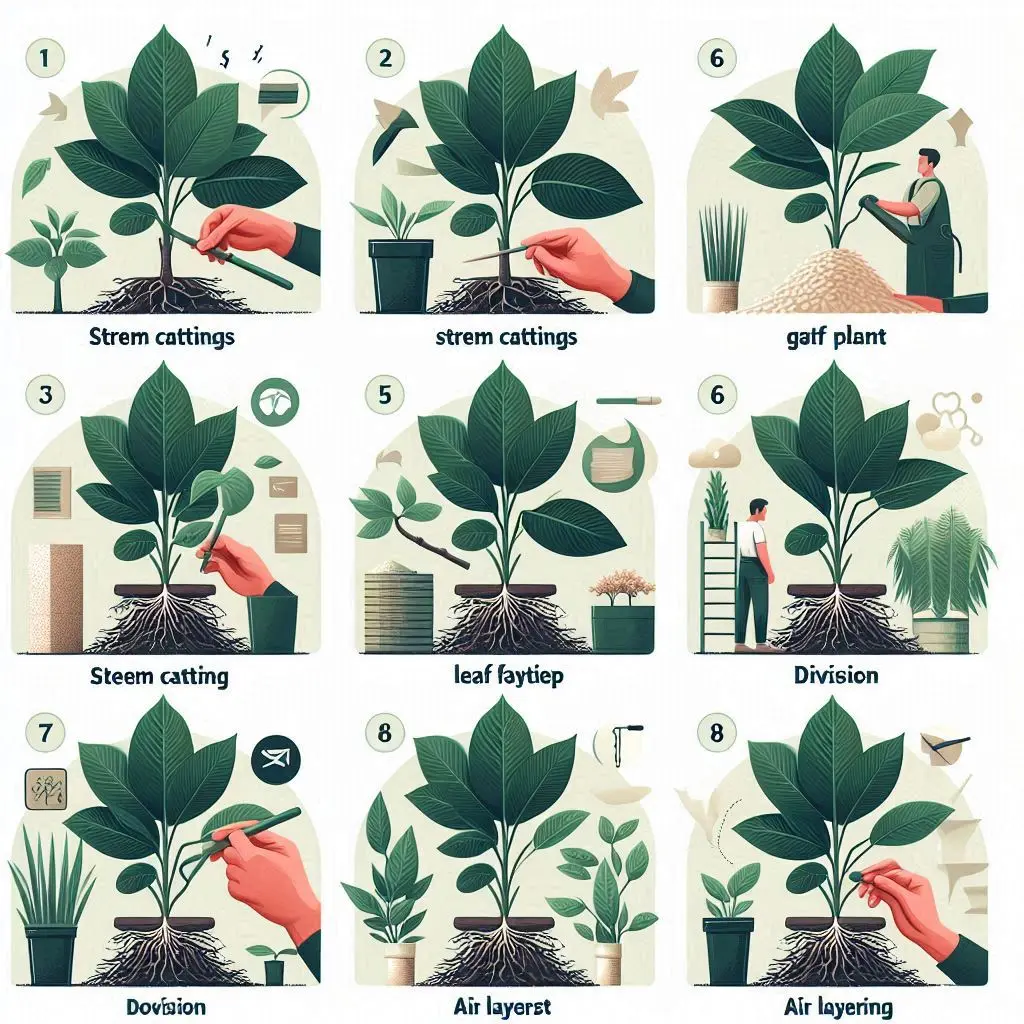
Since Zamiifolia Black is a unique and rare plant, you may want to propagate it like many others to increase the number of these plants or perhaps share them as gifts with your loved ones. The good news is that propagating Zamiifolia Black is very easy! For propagation, you can use methods such as stem cutting, leaf cutting, or dividing the plant.
During the care of Zamiifolia Black, the simplest and most effective method of propagating this plant is by dividing its roots. Simply divide the root ball into two parts while transplanting the plant. This method preserves the current root system and allows the plant to quickly recover in the new pot, encouraging the growth of new sections. It’s that easy!
However, if dividing is not suitable for you or you don’t want to take the plant out of its pot (for instance, if the plant is tightly attached to the pot), you can propagate the plant through stem cutting. For this, place a part of the stem or leaf in water and wait for the roots to appear. Once the roots emerge, plant them in small pots with moist soil. Keep in mind that while stem cutting may seem easier in the initial stages, it has a lower success rate and requires more care.
Pruning Method:
It’s true that Zamiifolia Black captivates every observer, but this shouldn’t allow you to let the entire living space be covered with this plant! The tall stems of this plant can grow excessively and even obstruct the light access for other plants. To control these branches, simply cut them from the point of attachment to the main stem and give the plant a more regular shape. However, when pruning, be careful not to let your skin come into contact with the sap inside the stems.
Also, our recommendation is that if you lack experience in pruning, seek assistance from a specialist and entrust this task to them. Moreover, when pruning the plant, it’s a good time to take cuttings, and with the help of cuttings, you can have several new Zamiifolia plants.
Read the care of the black ZZ plant from the easyplant site:
The Black ZZ Plant stands out for its adaptability and low-maintenance requirements. Regularly turning the pot ensures even light exposure, enhancing its overall growth. The Black ZZ plant is drought-tolerant, so it’s crucial to avoid overwatering. Its lustrous dark leaves can sometimes accumulate dust, so gently wipe them with a soft, damp cloth to maintain their sheen and allow the plant to photosynthesize more effectively. Also, while the Black ZZ Plant is more resistant to pests than other houseplants, it’s good practice to inspect it periodically for any signs of infestation.
Flowering:
Zamiifolia Black is considered one of the flowering plants, and in late summer to early autumn, it displays its small blooms. However, these flowers are very small and are not easily noticeable. In other words, the primary purpose of caring for Zamiifolia Black is to appreciate the beauty of its distinctive leaves.
Pests and Common Diseases During the Care of Zamiifolia Black:
Zamiifolia Black is notably resistant to various pests and diseases; however, it may be susceptible to common pests such as spider mites or mealybugs. Therefore, during the care of Zamiifolia Black, try to inspect all its parts and surrounding plants at least once a month. If anything suspicious is found, identify it promptly and take quick action to address the issue.
If your plant is affected by pests, you can use a soap and water spray or resort to specific pesticides for treatment.
Regarding common diseases during the care of Zamiifolia Black, the most likely infection is “root rot,” which occurs as a result of excessive watering, leading to yellowing of the leaves. To treat this, ensure proper drainage, and suspend watering for six weeks. Only resume watering when you are sure that the soil drainage is adequate and the soil and pot can completely remove excess water.
It’s worth mentioning that if the soil in your Zamiifolia pot lacks proper drainage, adding some perlite or sand can be a good solution.
In this article, we aimed to provide you with all the necessary information about caring for Zamiifolia Black. If there is anything left unsaid or if you have questions that require specialized advice on your plant, you can ask your questions through online consultation with Golgostaran. Our experienced plant health consultants are ready to answer your questions. They will examine your plant’s issue and, if necessary, provide you with plant nutrition (fertilizer), pesticides, and other plant essentials. Additionally, if you lack the time or expertise to care for your plant, you can use the gardening services in Tehran provided by Golgostaran (sending a gardener and plant doctor to your location). Our experts will come to your place with the necessary tools and offer services such as disease diagnosis, identifying growth issues, soil and pot replacement, pest control, fertilization, or even planting.

